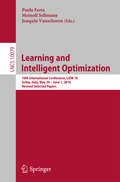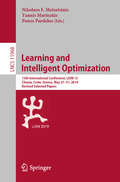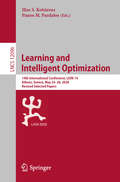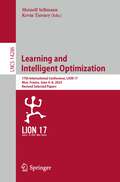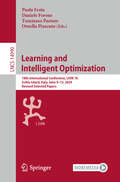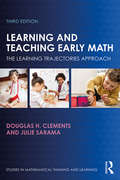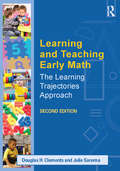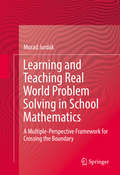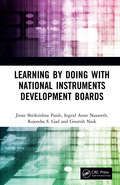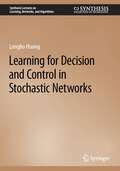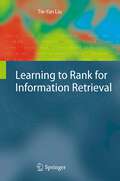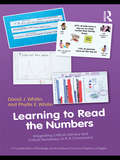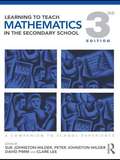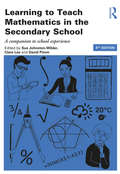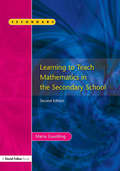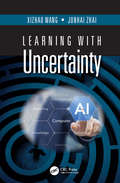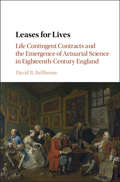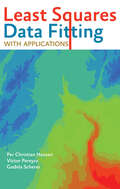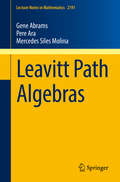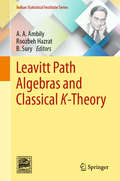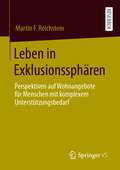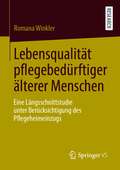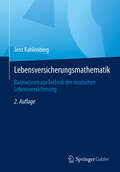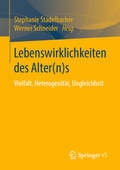- Table View
- List View
Learning and Intelligent Optimization
by Paola Festa Meinolf Sellmann Joaquin VanschorenThis book constitutes the thoroughly refereed post-conference proceedings of the 10th International Conference on Learning and Optimization, LION 10, which was held on Ischia, Italy, in May/June 2016. The 14 full papers presented together with 9 short papers and 2 GENOPT papers were carefully reviewed and selected from 47 submissions. The papers address all fields between machine learning, artificial intelligence, mathematical programming and algorithms for hard optimization problems. Special focus is given to new ideas and methods; challenges and opportunities in various application areas; general trends, and specific developments.
Learning and Intelligent Optimization: 13th International Conference, LION 13, Chania, Crete, Greece, May 27–31, 2019, Revised Selected Papers (Lecture Notes in Computer Science #11968)
by Panos Pardalos Nikolaos F. Matsatsinis Yannis MarinakisThis book constitutes the thoroughly refereed pChania, Crete, Greece, in May 2019. The 38 full papers presented have been carefully reviewed and selected from 52 submissions. The papers focus on advancedresearch developments in such interconnected fields as mathematical programming, global optimization, machine learning, and artificial intelligence and describe advanced ideas, technologies, methods, and applications in optimization and machine learning.
Learning and Intelligent Optimization: 14th International Conference, LION 14, Athens, Greece, May 24–28, 2020, Revised Selected Papers (Lecture Notes in Computer Science #12096)
by Panos M. Pardalos Ilias S. KotsireasThis book constitutes the refereed post-conference proceedings on Learning and Intelligent Optimization, LION 14, held in Athens, Greece, in May 2020. The 37 full papers presented together with one invited paper have been carefully reviewed and selected from 75 submissions. LION deals with designing and engineering ways of "learning" about the performance of different techniques, and ways of using past experience about the algorithm behavior to improve performance in the future. Intelligent learning schemes for mining the knowledge obtained online or offline can improve the algorithm design process and simplify the applications of high-performance optimization methods. Combinations of different algorithms can further improve the robustness and performance of the individual components. Due to the COVID-19 pandemic, LION 14 was not held as a physical meeting.
Learning and Intelligent Optimization: 17th International Conference, LION 17, Nice, France, June 4–8, 2023, Revised Selected Papers (Lecture Notes in Computer Science #14286)
by Kevin Tierney Meinolf SellmannThis book constitutes the refereed proceedings of the 17th International Conference on Learning and Intelligent Optimization, LION-17, held in Nice, France, during June 4–8, 2023.The 40 full papers presented have been carefully reviewed and selected from 83 submissions. They focus on all aspects of unleashing the potential of integrating machine learning and optimization approaches, including automatic heuristic selection, intelligent restart strategies, predict-then-optimize, Bayesian optimization, and learning to optimize.
Learning and Intelligent Optimization: 18th International Conference, LION 18, Ischia Island, Italy, June 9–13, 2024, Revised Selected Papers (Lecture Notes in Computer Science #14990)
by Paola Festa Ornella Pisacane Daniele Ferone Tommaso PastoreThis book constitutes the refereed proceedings of the 18th International Conference on Learning and Intelligent Optimization, LION 18, held in Ischia Island, Italy, in June 2024. The 31 full papers and 4 short papers presented in these proceedings were carefully reviewed and selected from 58 submissions. These papers focus on the current research, challenges and applications in the fields of Artificial Intelligent, Machine Learning and Operations Research.
Learning and Teaching Early Math: The Learning Trajectories Approach (Studies in Mathematical Thinking and Learning Series)
by Douglas H. Clements Julie SaramaThe third edition of this significant and groundbreaking book summarizes current research into how young children learn mathematics and how best to develop foundational knowledge to realize more effective teaching. Using straightforward, practical language, early math experts Douglas Clements and Julie Sarama show how learning trajectories help teachers understand children’s level of mathematical understanding and lead to better teaching. By focusing on the inherent delight and curiosity behind young children’s mathematical reasoning, learning trajectories ultimately make teaching more joyous: helping teachers understand the varying levels of knowledge exhibited by individual students, it allows them to better meet the learning needs of all children. This thoroughly revised and contemporary third edition of Learning and Teaching Early Math remains the definitive, research-based resource to help teachers understand the learning trajectories of early mathematics and become confident, credible professionals. The new edition draws on numerous new research studies, offers expanded international examples, and includes updated illustrations throughout. This new edition is closely linked with Learning and Teaching with Learning Trajectories–[LT]²–an open-access, web-based tool for early childhood educators to learn about how children think and learn about mathematics. Head to LearningTrajectories.org for ongoing updates, interactive games, and practical tools that support classroom learning.
Learning and Teaching Early Math: The Learning Trajectories Approach (Studies in Mathematical Thinking and Learning Series)
by Douglas H. Clements Julie SaramaIn this important book for pre- and in-service teachers, early math experts Douglas Clements and Julie Sarama show how "learning trajectories" help diagnose a child's level of mathematical understanding and provide guidance for teaching. By focusing on the inherent delight and curiosity behind young children's mathematical reasoning, learning trajectories ultimately make teaching more joyous. They help teachers understand the varying levels of knowledge exhibited by individual students, which in turn allows them to better meet the learning needs of all children. Using straightforward, no-nonsense language, this book summarizes the current research about how children learn mathematics, and how to build on what children already know to realize more effective teaching. This second edition of Learning and Teaching Early Math remains the definitive, research-based resource to help teachers understand the learning trajectories of early mathematics and become quintessential professionals. Updates to the new edition include: * Explicit connections between Learning Trajectories and the new Common Core State Standards. * New coverage of patterns and patterning. * A companion website featuring student support materials such as a glossary of technical terms and pedagogical activities. * Incorporation of hundreds of recent research studies.
Learning and Teaching Real World Problem Solving in School Mathematics
by Murad JurdakThe ultimate aim of this book is to identify the conceptual tools and the instructional modalities which enable students and teachers to cross the boundary between school mathematics and real world problem solving. The book identifies, examines, and integrates seven conceptual tools, of which five are constructs (activity theory, narrative, modeling, critical mathematics education, ethnomathematics) and two are contexts (STEM and the workplace). The author develops two closely linked multiple-perspective frameworks: one for learning real world problem solving in school mathematics, which sets the foundations of learning real world problem solving in school mathematics; and one for teaching real world problem solving in school mathematics, which explores the modalities of teaching real world problem solving in school mathematics. "The book is composed as, on the one hand, a high-level theoretical scholarly work on real world problem solving in school mathematics, and, on the other hand, a set of twelve narratives which, put together, constitute a thought-provoking and moving personal and professional autobiography. " - Mogens Niss "These narratives combine aspects of Murad's personal trajectory as an individual with those points in his professional career at which he became aware of perspectives on and approaches to mathematics education that were both significant in and of themselves, and instrumental for the specific scholarly endeavor presented in the book. " - Mogens Niss
Learning by Doing with National Instruments Development Boards
by Rajendra S. Gad Jivan Shrikrishna Parab Ingrid Anne Nazareth Gourish NaikLearning by Doing with National Instruments Development Boards starts with a brief introduction to LabVIEW programming, which is required to explore the National Instrument platform, an introduction that includes detailed installation and licensing setup. Further, it gives the features and configuration setup of NI SPEEDY-33, NI ELVIS and myRIO boards. The focus of the book is on worked-out case studies for students working in different areas of electronics such as basic digital design, biomedical instrumentation, sensors and measurement. Data acquisition using SPEEDY-33, NI –ELVIS and myRIO kits is also odiscussed. The book also examines the myRIO platform.
Learning for Decision and Control in Stochastic Networks (Synthesis Lectures on Learning, Networks, and Algorithms)
by Longbo HuangThis book introduces the Learning-Augmented Network Optimization (LANO) paradigm, which interconnects network optimization with the emerging AI theory and algorithms and has been receiving a growing attention in network research. The authors present the topic based on a general stochastic network optimization model, and review several important theoretical tools that are widely adopted in network research, including convex optimization, the drift method, and mean-field analysis. The book then covers several popular learning-based methods, i.e., learning-augmented drift, multi-armed bandit and reinforcement learning, along with applications in networks where the techniques have been successfully applied. The authors also provide a discussion on potential future directions and challenges.
Learning in Doing: Constructing Dynamic Triangles Together
by Gerry StahlRational thinking as exemplified in mathematical cognition is immensely important in the modern world. This book documents how a group of three eighth-grade girls developed specific group practices typical of such thinking in an online educational experience. A longitudinal case study tracks the team through eight hour-long sessions, following the students' meaning-making processes through their mutual chat responses preserved in computer logs coordinated with their geometric actions. The examination of data focuses on key areas of the team's development: its effective team collaboration, its productive mathematical discourse, its enacted use of dynamic-geometry tools, and its ability to identify and construct dynamic-geometry dependencies. This detailed study of group cognition serves as a paradigmatic example of computer-supported collaborative learning, incorporating a unique model of human-computer interaction analysis applied to the use of innovative educational technology. A valuable resource for researchers, instructors, and students alike, it offers concrete suggestions for improving educational practice.
Learning to Rank for Information Retrieval
by Tie-Yan LiuDue to the fast growth of the Web and the difficulties in finding desired information, efficient and effective information retrieval systems have become more important than ever, and the search engine has become an essential tool for many people. The ranker, a central component in every search engine, is responsible for the matching between processed queries and indexed documents. Because of its central role, great attention has been paid to the research and development of ranking technologies. In addition, ranking is also pivotal for many other information retrieval applications, such as collaborative filtering, definition ranking, question answering, multimedia retrieval, text summarization, and online advertisement. Leveraging machine learning technologies in the ranking process has led to innovative and more effective ranking models, and eventually to a completely new research area called "learning to rank". Liu first gives a comprehensive review of the major approaches to learning to rank. For each approach he presents the basic framework, with example algorithms, and he discusses its advantages and disadvantages. He continues with some recent advances in learning to rank that cannot be simply categorized into the three major approaches - these include relational ranking, query-dependent ranking, transfer ranking, and semisupervised ranking. His presentation is completed by several examples that apply these technologies to solve real information retrieval problems, and by theoretical discussions on guarantees for ranking performance. This book is written for researchers and graduate students in both information retrieval and machine learning. They will find here the only comprehensive description of the state of the art in a field that has driven the recent advances in search engine development.
Learning to Read the Numbers: Integrating Critical Literacy and Critical Numeracy in K-8 Classrooms. A Co-Publication of The National Council of Teachers of English and Routledge
by David J. Whitin Phyllis E. WhitinBeing a critical reader of numerical information is an integral part of being literate in today’s data-drenched world. Uniquely addressing both mathematics and language issues, this text shows how critical readers dig beneath the surface of data to better evaluate their usefulness and to understand how numbers are constructed by authors to portray a certain version of reality. Engaging, concise, and rich with examples and clear connections to classroom practice, it provides a framework of critical questions that children and teachers can pose to crack open authors’ intentions, expose their decisions, and make clear who are the winners and losers – questions that are essential for building democratic classrooms. Explaining and illustrating how K-8 teachers can engage students in developing the ability to be both critical composers and critical readers of texts, Learning to Read the Numbers is designed for teacher education courses across the areas of language arts, mathematics, and curriculum studies, and for elementary teachers, administrators, and literacy and mathematics coaches. Learning to Read the Numbers is a co-publication of The National Council of Teachers of English (www.ncte.org) and Routledge.
Learning to Teach Mathematics in the Secondary School: A Companion to School Experience
by David Pimm Sue Johnston-Wilder Clare LeeWhat is the role of mathematics in the secondary classroom? What is expected of a would-be maths teacher? How is mathematics best taught and learnt? Learning to Teach Mathematics in the Secondary School combines theory and practice to present a broad introduction to the opportunities and challenges of teaching mathematics in the modern secondary school classroom. Written specifically with the new and student teacher in mind, the book covers a wide range of issues related to the teaching of mathematics, including: The role of ICT Assessment for Learning NEW Using mathematics in context NEW Communicating mathematically Planning mathematics lessons Including special-needs pupils Teaching mathematics post-16 Professional Development Already a major text for many university teaching courses, this fully revised third edition takes into account new developments in the National Curriculum as well as recent changes to the standards for Qualified Teacher Status. Featuring two brand new chapters, a glossary of useful terms, addresses for resources and organisations, and tasks designed to prompt critical reflection and support thinking and writing at Masters level, this book will help you make the most of school experience, during your training and beyond. Designed for use as a core textbook, this new edition of Learning to Teach Mathematics in the Secondary School provides essential guidance and advice for all trainee and practising teachers of secondary mathematics.
Learning to Teach Mathematics in the Secondary School: A companion to school experience (Learning to Teach Subjects in the Secondary School Series)
by David Pimm Sue Johnston-Wilder Clare LeeLearning to Teach Mathematics in the Secondary School combines theory and practice to present a broad introduction to the opportunities and challenges of teaching mathematics in the secondary school classroom. This fourth edition has been fully updated to reflect the latest changes to the curriculum and research in the field, taking into account key developments in teacher training and education, including examinations and assessment. Written specifically with the new and student teacher in mind, the book covers a wide range of issues related to the teaching of mathematics, such as: why we teach mathematics the place of mathematics in the National Curriculum planning, teaching and assessing for mathematics learning how to communicate mathematically using digital technology to advance mathematical learning working with students with special educational needs post-16 teaching the importance of professional development the affective dimension when learning mathematics, including motivation, confidence and resilience Already a major text for many university teaching courses, this revised edition features a glossary of useful terms and carefully designed tasks to prompt critical reflection and support thinking and writing up to Masters Level. Issues of professional development are also examined, as well as a range of teaching approaches and styles from whole-class strategies to personalised learning, helping you to make the most of school experience, during your training and beyond. Designed for use as a core textbook, Learning to Teach Mathematics in the Secondary School provides essential guidance and advice for all those who aspire to be effective mathematics teachers.
Learning to Teach Mathematics, Second Edition
by Maria GouldingRefreshed with new research, this second edition links the practical experience gained in school placements with the theoretical background surrounding it. Guidance is drawn from accounts of experiences in actual classrooms, giving students and newly qualified teachers practical ideas for planning and evaluating pupils' learning and insights into their own development as new teachers.
Learning with Uncertainty
by Xizhao Wang Junhai ZhaiLearning with uncertainty covers a broad range of scenarios in machine learning, this book mainly focuses on: (1) Decision tree learning with uncertainty, (2) Clustering under uncertainty environment, (3) Active learning based on uncertainty criterion, and (4) Ensemble learning in a framework of uncertainty. The book starts with the introduction to uncertainty including randomness, roughness, fuzziness and non-specificity and then comprehensively discusses a number of key issues in learning with uncertainty, such as uncertainty representation in learning, the influence of uncertainty on the performance of learning system, the heuristic design with uncertainty, etc. <P><P>Most contents of the book are our research results in recent decades. The purpose of this book is to help the readers to understand the impact of uncertainty on learning processes. It comes with many examples to facilitate understanding. The book can be used as reference book or textbook for researcher fellows, senior undergraduates and postgraduates majored in computer science and technology, applied mathematics, automation, electrical engineering, etc.
Leases for Lives: Life Contingent Contracts and the Emergence of Actuarial Science in Eighteenth-Century England
by David R. BellhouseMany historians of insurance have commented on the disconnect between the rise of English life insurance companies in the early eighteenth century and the mathematics behind the sound pricing of life insurance products that was developed at about the same time. Insurance and annuity promoters typically ignored this mathematical work. Bellhouse explores this issue, and shows that the early mathematical work was not motivated by insurance but instead by the fair valuation of life contingent contracts related to property. Even the work of the mathematician James Dodson in the creation of the Equitable Life Assurance Society, offering sound actuarially based premiums, did not change the industry in any significant way. The tipping point was a crisis in 1770 in which the philosopher and mathematician Richard Price, as well as other mathematicians, showed that a dozen or more recently formed annuity societies could not meet their financial obligations and were inviable.
Least Squares Data Fitting with Applications
by Per Christian Hansen Víctor Pereyra Godela SchererA lucid explanation of the intricacies of both simple and complex least squares methods.As one of the classical statistical regression techniques, and often the first to be taught to new students, least squares fitting can be a very effective tool in data analysis. Given measured data, we establish a relationship between independent and dependent variables so that we can use the data predictively. The main concern of Least Squares Data Fitting with Applications is how to do this on a computer with efficient and robust computational methods for linear and nonlinear relationships. The presentation also establishes a link between the statistical setting and the computational issues.In a number of applications, the accuracy and efficiency of the least squares fit is central, and Per Christian Hansen, Víctor Pereyra, and Godela Scherer survey modern computational methods and illustrate them in fields ranging from engineering and environmental sciences to geophysics. Anyone working with problems of linear and nonlinear least squares fitting will find this book invaluable as a hands-on guide, with accessible text and carefully explained problems.Included are• an overview of computational methods together with their properties and advantages• topics from statistical regression analysis that help readers to understand and evaluate the computed solutions• many examples that illustrate the techniques and algorithmsLeast Squares Data Fitting with Applications can be used as a textbook for advanced undergraduate or graduate courses and professionals in the sciences and in engineering.
Leavitt Path Algebras
by Mercedes Siles Molina Gene Abrams Pere AraThis book offers a comprehensive introduction by three of the leading experts in the field, collecting fundamental results and open problems in a single volume. Since Leavitt path algebras were first defined in 2005, interest in these algebras has grown substantially, with ring theorists as well as researchers working in graph C*-algebras, group theory and symbolic dynamics attracted to the topic. Providing a historical perspective on the subject, the authors review existing arguments, establish new results, and outline the major themes and ring-theoretic concepts, such as the ideal structure, Z-grading and the close link between Leavitt path algebras and graph C*-algebras. The book also presents key lines of current research, including the Algebraic Kirchberg Phillips Question, various additional classification questions, and connections to noncommutative algebraic geometry. Leavitt Path Algebras will appeal to graduate students and researchers working in the field and related areas, such as C*-algebras and symbolic dynamics. With its descriptive writing style, this book is highly accessible.
Leavitt Path Algebras and Classical K-Theory (Indian Statistical Institute Series)
by Roozbeh Hazrat A. A. Ambily B. SuryThe book offers a comprehensive introduction to Leavitt path algebras (LPAs) and graph C*-algebras. Highlighting their significant connection with classical K-theory—which plays an important role in mathematics and its related emerging fields—this book allows readers from diverse mathematical backgrounds to understand and appreciate these structures. The articles on LPAs are mostly of an expository nature and the ones dealing with K-theory provide new proofs and are accessible to interested students and beginners of the field. It is a useful resource for graduate students and researchers working in this field and related areas, such as C*-algebras and symbolic dynamics.
Leben in Exklusionssphären: Perspektiven auf Wohnangebote für Menschen mit komplexem Unterstützungsbedarf
by Martin F. ReichsteinIm Bereich wohnbezogener Hilfen für Menschen mit sogenannter geistiger Behinderung treten systemisch und systematisch ,Exklusionssphären‘ in Form von hochspezialisierten Angeboten sowie ,Resteinrichtungen‘ auf. Hiervon sind aktuell Menschen mit komplexen Unterstützungsbedarfen besonders betroffen. Der Autor untersucht am Beispiel von Menschen mit sogenannter geistiger Behinderung und herausforderndem Verhalten, schwerer bzw. mehrfacher Beeinträchtigung sowie fortgeschrittenem bzw. hohem Lebensalter explorativ das Entstehen von ,Exklusionssphären‘ sowie deren Auswirkungen auf die individuelle Lebensqualität und die persönlichen Sozialräume betroffener Personen.
Lebensqualität pflegebedürftiger älterer Menschen: Eine Längsschnittstudie unter Berücksichtigung des Pflegeheimeinzugs
by Romana WinklerRomana Winkler untersucht den Einfluss des Pflegeheimeinzugs sowie ausgewählter Aspekte sozialer Ungleichheit auf die Lebensqualität pflege- und betreuungsbedürftiger älterer Menschen in Österreich. Dies erfolgt durch eine Längsschnittstudie beim Einzug in das Pflegeheim sowie eine und zwölf Wochen danach, und zwar durch eine Mehrebenenanalyse, die strukturelle Unterschiede zwischen Pflegeheimen mitberücksichtigt. Detailliert analysiert die Autorin Einflussfaktoren auf die Gesamt-Lebensqualität und Teilbereiche sowie Gründe für eine Verbesserung bzw. Verschlechterung. Sie liefert Anregungen für weitere Forschungsaktivitäten und konkrete Handlungsempfehlungen für die Praxis.
Lebensversicherungsmathematik: Basiswissen zur Technik der deutschen Lebensversicherung
by Jens KahlenbergDieses Buch gibt eine ausführliche und verständliche Einführung in die Technik der deutschen Lebensversicherung. Nach einer allgemeinen Einleitung werden die Rechnungsgrundlagen Zins, Biometrie und Kosten, die Berechnung von Prämien, Leistungen und Reserven sowie die Überschussbeteiligung erläutert. Über diese klassische Lebensversicherungsmathematik hinaus geht der Autor detailliert auf die Darstellung fondsgebundener Tarife ein und beschreibt auch das komplexe Teilgebiet der Berufsunfähigkeitsversicherung in aller Tiefe. Zudem werden Aspekte der Pflegeversicherung sowie Fragestellungen des Jahresabschlusses und der Bilanzierung behandelt. Zahlreiche Übungsaufgaben inklusive Lösungen unterstützen das Selbststudium und veranschaulichen die versicherungstechnischen Vorgehensweisen. Ein umfassender Anhang mit biometrischen Rechnungsgrundlagen, mathematischen Grundformeln, Wörterbuch und Symbolverzeichnis rundet das Werk ab.
Lebenswirklichkeiten des Alter(n)s: Vielfalt, Heterogenität, Ungleichheit
by Werner Schneider Stephanie StadelbacherAlter(n) ist eine gesellschaftliche Konstruktion, die sich abhängig von soziokulturellen und sozialstrukturellen Rahmenbedingungen auf der einen Seite und lebensweltlichen Bezügen, Interaktions- und Beziehungssystemen auf der anderen Seite realisiert. Im Sammelband soll ein Blick in die verschiedenen Lebenswelten der Älterwerdenden und Alten im Sinne von gesellschaftlich gerahmten, sozial gestalteten und subjektiv wahrgenommenen Wirklichkeiten des Alter(n)s in unserer Gesellschaft geworfen werden. Als relevante lebensweltliche Bereiche werden hier Gesundheit, Arbeit (und Freizeit), Wohnen, Familie/soziale Beziehungen, Sozialraum, soziales Engagement bis hin zu Pflege und Lebensende betrachtet. In den Beiträgen sollen Gegenwartsanalysen und mögliche Zukunftsszenarien zum Älterwerden und Altsein in unserer Gesellschaft skizziert werden.
